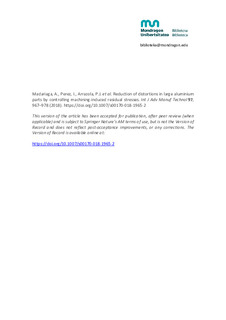| dc.contributor.author | Madariaga, Aitor | |
| dc.contributor.author | ARRAZOLA, PEDRO JOSE | |
| dc.contributor.other | Rubio, F.J. | |
| dc.contributor.other | Pérez, I. | |
| dc.contributor.other | Ruiz, J.J. | |
| dc.date.accessioned | 2022-09-01T10:13:11Z | |
| dc.date.available | 2022-09-01T10:13:11Z | |
| dc.date.issued | 2018 | |
| dc.identifier.issn | 0268-3768 | en |
| dc.identifier.other | https://katalogoa.mondragon.edu/janium-bin/janium_login_opac.pl?find&ficha_no=148473 | en |
| dc.identifier.uri | https://hdl.handle.net/20.500.11984/5651 | |
| dc.description.abstract | Large aluminium monolithic parts used in the aeronautic industry frequently show significant geometric distortions after the machining process. These distortions are the consequence of the initial residual stresses of the raw material as well as machining-induced residual stresses. Therefore, to minimise distortions, it is fundamental to understand the effect of the different parameters of the manufacturing process and define the optimum manufacturing strategy. This work studies the effect of initial residual stresses of aluminium plates and the residual stresses generated by the machining process on the final geometric distortions of the part. First, 7175-T7351 aluminium bars (40 mm wide × 38 mm thick × 400 mm long) were face milled at two different cutting conditions reducing the thickness to 6 mm. The distortions were measured in a coordinate measuring machine. The results revealed that the machining strategy significantly influenced the distortions, as a difference of 65% on distortions was found between the two cutting conditions. In addition, an FEM model to predict distortions was developed. This model considers initial residual stresses (measured by the contour method) and residual stresses induced by the machining process (measured by the hole drilling technique). Once the FEM model was validated, the study was extended to more complex geometries. These new studies revealed that final distortions are sensitive to machining-induced residual stresses. Furthermore, this finding indicates that it is possible to define machining conditions which generate desirable residual stress profiles to minimise part distortion. | en |
| dc.description.sponsorship | Gobierno de España | es |
| dc.description.sponsorship | Gobierno Vasco | es |
| dc.language.iso | eng | en |
| dc.publisher | Springer | en |
| dc.rights | © 2018, Springer-Verlag London Ltd., part of Springer Nature | en |
| dc.subject | Aerospace | en |
| dc.subject | Machining | en |
| dc.subject | Distortions | en |
| dc.subject | Residual stress | en |
| dc.title | Reduction of distortions in large aluminium parts by controlling machining-induced residual stresses | en |
| dc.type | http://purl.org/coar/resource_type/c_6501 | |
| dcterms.accessRights | http://purl.org/coar/access_right/c_abf2 | en |
| dcterms.source | The International Journal of Advanced Manufacturing Technology. | en |
| local.contributor.group | Mecanizado de alto rendimiento | es |
| local.description.peerreviewed | true | en |
| local.description.publicationfirstpage | 967 | en |
| local.description.publicationlastpage | 978 | en |
| local.identifier.doi | https://doi.org/10.1007/s00170-018-1965-2 | en |
| local.relation.projectID | info:eu-repo/grantAgreement/GE/CDTI Proyectos estratégicos CIEN 2014/CIEN_IDI-20141299/ES/Nuevas Tecnologías de Automatización de Procesos para Empenajes/TEMPROCEN | en |
| local.relation.projectID | info:eu-repo/grantAgreement/GV/Adquisición de equipamiento científico 2016/EC_2016_1_0015/Equipo de hole-drilling de alta precisión automatizado para medición de tensiones residuales/HDAUTO | en |
| local.contributor.otherinstitution | Aerometallic | es |
| local.source.details | Vol. 97. Nº. 1–4. Pp. 967–978. Springer. July, 2018 | en |
| oaire.format.mimetype | application/pdf | |
| oaire.file | $DSPACE\assetstore | |
| oaire.resourceType | http://purl.org/coar/resource_type/c_6501 | en |
| oaire.version | http://purl.org/coar/version/c_ab4af688f83e57aa | en |







